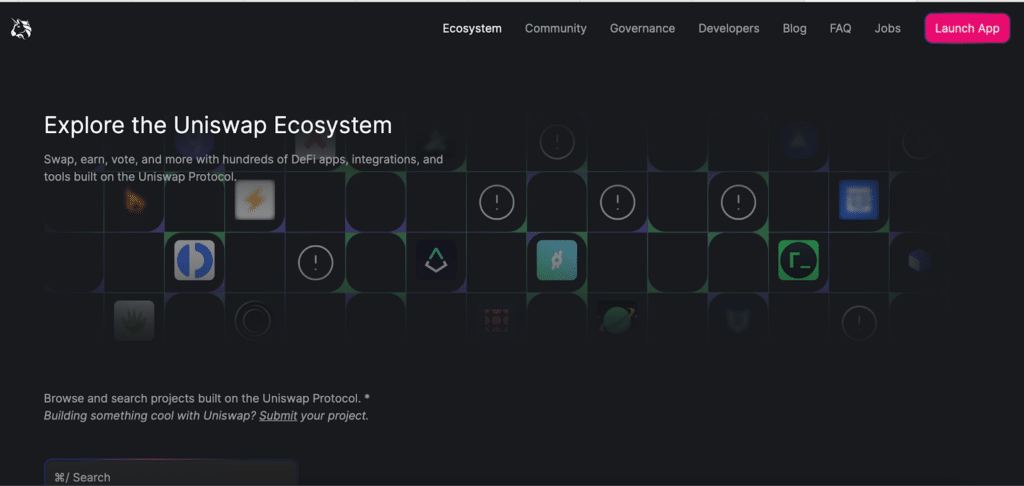Uniswap is one of the leading decentralized cryptocurrency exchanges, allowing easy and seamless token swapping. With its user-friendly interface and liquidity mining options, Uniswap has become a top choice for crypto traders and liquidity providers alike. Let’s look at our comprehensive Uniswap review to understand its key features, pros and cons, fees, security, and more.
Features of Uniswap
- Swap over 800 different ERC-20 tokens directly from your wallet
- Provide liquidity and earn fees on trades
- Completely decentralized and non-custodial
- No KYC requirements
- Built on Ethereum with low transaction fees
- Developed an oracle aggregation protocol called Uniswap V3
- Has its own governance token UNI
Key Metrics:
- Uniswap has facilitated over $20 billion in trading volume across more than 8,000 unique crypto assets since launch.
- Over 250,000 unique addresses have traded on Uniswap, showing strong adoption and user base growth.
- There are over 49,000 unique liquidity providers that have contributed to Uniswap’s over $1 billion in total liquidity.
- Liquidity providers have earned over $56 million in fees through providing funds to pools.
- 60% of the total supply of 1 billion UNI tokens are allocated to the Uniswap community and past users. This includes 15% (150 million UNI) that can be immediately claimed.
- The UNI token enables participation in governance through voting and submissions. 1% of supply is needed to submit proposals.
- Uniswap will have an initial 4-year UNI distribution period with a fixed perpetual inflation rate of 2% per year after that.
- The protocol fee switch and ENS name ownership are key governance assets that UNI holders will control.
- There is a 30-day timelock on transfers from the UNI community treasury, which will have 43% of tokens.
Uniswap Review of Pros and Cons
| Pros | Cons |
| Easy to use interface and trading experience | Only supports ERC-20 tokens built on Ethereum |
| No KYC verification needed | Transaction fees can be high during times of network congestion |
| Access to a wide variety of tokens | Impermanent loss risk with liquidity pools |
| Earn passive income through liquidity pools | Less liquidity for minor token pairs |
| Decentralized for better security | Higher fees compared to centralized exchanges for major coins |
| Transparent system | Subject to regulatory uncertainty |
Uniswap Fees
Uniswap charges a 0.3% fee on all trades, which is distributed pro-rata to liquidity providers. The exact fee can range from 0.01% for stablecoin pools to 1% for exotic, volatile pairs.
This fee structure is higher compared to top centralized exchanges like Coinbase or Binance, which offer maker/taker fee models starting at 0.1%. However, Uniswap does not charge deposit or withdrawal fees.
Uniswap Security
As a non-custodial decentralized exchange, Uniswap offers better security compared to centralized platforms. Users maintain control of their private keys and funds at all times when interacting with Uniswap.
Smart contracts power the exchange, eliminating counterparty risk. Uniswap’s code is open-source and has been audited multiple times by firms like Trail of Bits, improving transparency. Overall, it has a strong track record with no major hacks.
Uniswap’s Account Verification Process
Uniswap does not require any KYC verification to use the platform. Users only need a crypto wallet like MetaMask to connect and start trading. This improves privacy but may lead to restrictions for users in certain jurisdictions.
Uniswap’s Customer Service
Uniswap does not have direct customer service support given its decentralized nature. Users have to rely on community-run channels like Discord and GitHub discussions for assistance. This could make it difficult for beginners to find help.
Response times in their public Discord vary. For common questions, users often get replies within a few hours. But complex issues could take over a day to get a detailed response. Overall, customer service is a weakness compared to centralized exchanges.
Uniswap’s User Experience
Uniswap offers an easy-to-use platform that even beginners can quickly understand. The interface is clean and intuitive with options to swap, provide liquidity, stake UNI, and more. Trading is as simple as connecting your wallet, inputting tokens, and approving transactions.
However, the lack of charts, indicators, and order books may dissatisfy advanced traders used to centralized exchange layouts. Uniswap also lacks educational content about trading concepts. But it excels in usability for DeFi beginners.
Available Tokens on Uniswap
Uniswap supports over 800 tokens but only ERC-20 assets built on the Ethereum blockchain can be traded. This includes major coins like SHIB, Chainlink, Stablecoins, and more. UNI is Uniswap’s native token used for governance and earning fees.
However, Bitcoin, Ripple, Binance Coin and other non-ERC20 coins have to be traded through wrapped versions on Uniswap. The exchange plans to expand to other blockchains like Optimism and Arbitrum to boost token support.

Regulatory Compliance and Legal Status
Decentralized exchanges like Uniswap operate in a legal gray area currently. Without KYC checks, regulators can argue it facilitates illegal transactions. Its decentralized structure also makes it non-compliant with licenses needed for centralized exchanges.
So far, Uniswap has not faced any direct legal action but it remains at risk if regulators clamp down on DeFi. Users could see limited access if their jurisdictions ban decentralized crypto trading.
Liquidity and Volume on Uniswap
Uniswap currently processes over $1 billion in daily trading volume across all pairs. This makes it one of the most liquid decentralized exchanges.
The most popular pairs like ETH/USDC, ETH/USDT, and ETH/WBTC have depths of over $10 million ensuring smooth large volume trades. But more exotic pairs may have low liquidity and wide spreads.
Staking and Lending Options
The UNI token serves as Uniswap’s governance token and grants holders a share of protocol fees. UNI holders can stake their tokens to earn yield.
Current UNI staking APYs vary from 5-15% based on the amount staked. Users need a minimum of 100 UNI to participate in governance and staking.
Uniswap does not have crypto lending or borrowing features. To earn lending yields, users have to deposit tokens into Aave, Compound, and other DeFi lending platforms.
Uniswap App and Web Experience
Uniswap offers both a user-friendly web interface accessible via browsers and a mobile app on iOS and Android.
Uniswap Web Experience
Uniswap’s web platform, accessible at App.Uniswap.org provides the full trading experience. The interface is clean and intuitive with key features easily accessible. Trading, liquidity pools, and staking options are just a click away.
The graphs lack customization options compared to centralized exchanges. But overall, it is easy to use on both desktop and mobile browsers.
Uniswap Mobile App Experience
Uniswap’s mobile app provides similar core features as the web version. This includes a unified token list, swap function, and liquidity pool management. Charts and analytics tools are more limited on mobile, but trading is smooth.
The app also offers additional security with biometrics, auto log-out, and mandatory confirmations for actions like removing liquidity. Overall, the mobile experience retains the simplicity of Uniswap while adding security.
Final Recommendation on Using Uniswap
With its easy token swapping, liquidity mining, and growing list of supported assets, Uniswap stands out as a top decentralized exchange, especially for DeFi beginners. The automated market maker model provides simple trading without order books. Power users may miss advanced charting and analytics features, but the platform is improving. For accessing leading DeFi tokens in a secure, non-custodial manner, Uniswap is hard to beat.
Uniswap Alternatives
| Features | Uniswap | PancakeSwap | SushiSwap | 1inch |
| Interface | Simple | Simple | Moderate | Moderate |
| Fees | 0.3% | 0.2% | 0.3% | 0 – 1% |
| Blockchains | Ethereum | BSC | Multiple | Multiple |
| Staking APY | Up to 20% | Up to 150% | Up to 90% | None |
FAQs
What tokens can I trade on Uniswap?
You can trade any ERC-20 token built on the Ethereum blockchain on Uniswap, over 800 in total. Leading coins like Chainlink, Dai, Shiba Inu, and more are supported.
How do fees work on Uniswap?
Uniswap charges a 0.3% fee on trades, which is added to liquidity pools. You can provide liquidity to earn a share of these fees based on your share of the pool.
Is Uniswap safe to use?
Uniswap is a non-custodial platform, meaning you maintain control of your funds. Its code is open-source and regularly audited, improving transparency. Overall, it has a good safety record.
Can I stake or earn yields on Uniswap?
Yes, staking the UNI token allows you to earn yields ranging from 5-15% APY based on the amount staked. You need a minimum of 100 UNI to participate in staking.




